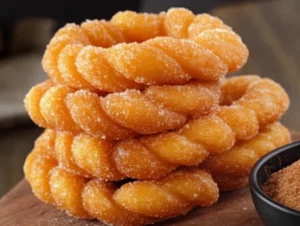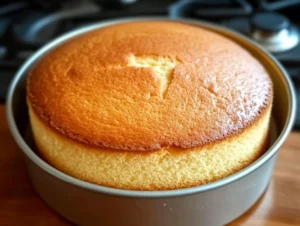There’s something truly magical about biting into a warm, sugar-coated donut, especially when it’s filled with silky pastry cream or luscious Nutella. If you’ve never had a Bombolone before (plural: Bomboloni), let me just say—get ready to fall in love! These Italian donuts are light, fluffy, and completely addictive. I’ve made these for lazy Sunday mornings, holiday brunches, and once, on a rainy Tuesday just because I needed a pick-me-up. Every time, they deliver that perfect blend of comfort and indulgence.
Today, I’m going to walk you through how to make these bakery-worthy Bomboloni right at home. Don’t worry—the process is super doable, even if you’re new to working with yeast doughs. Plus, I’ll share a few of my go-to tips to make sure they turn out pillowy and delicious every time.
So grab your apron, warm up that milk, and let’s get started on what might just become your new favorite homemade treat.
Why You’ll Love This Bomboloni Recipe
Think of these as the Italian cousin to your classic jelly donut—only lighter, richer, and honestly, a little fancier. The dough is enriched with eggs and butter, which gives each bite that soft, almost brioche-like texture. Then there’s the filling. Whether you go with a classic pastry cream or something more modern like dulce de leche or Nutella, it’s guaranteed to be delicious. And of course, the sugary coating? That’s just the cherry on top.
Ingredients You’ll Need
Let’s break this down so you can double-check your pantry before we jump into the steps.
For the Dough:
-
2¼ teaspoons active dry yeast (1 packet)
-
½ cup warm milk (about 110°F / 43°C)
-
3½ to 4 cups all-purpose flour, divided
-
¼ cup granulated sugar
-
½ teaspoon salt
-
3 large eggs, at room temperature
-
½ cup unsalted butter, softened
-
1 teaspoon vanilla extract
-
Vegetable oil, for frying
For the Filling:
-
Pastry cream, Nutella, jam, or dulce de leche
For the Coating:
-
1 cup granulated sugar, for rolling
STEP 1: Activate the Yeast
In a small bowl, combine the warm milk and active dry yeast. Give it a gentle stir and let it sit for about 5 to 10 minutes. You’re looking for a foamy, frothy top—that’s how you’ll know the yeast is alive and ready to work its magic. If it doesn’t foam, double-check that your milk isn’t too hot or cold, and make sure your yeast isn’t expired.
STEP 2: Make the Dough
In a large bowl (or the bowl of your stand mixer if you’re using one), whisk together 3 cups of the flour, sugar, and salt. Now pour in the activated yeast mixture, add the eggs, softened butter, and vanilla extract.
Mix everything together until a shaggy dough starts to come together. From here, you’ll want to knead the dough for about 8 to 10 minutes—by hand or with a dough hook—adding the remaining flour little by little as needed. You’re aiming for a dough that’s smooth, elastic, and just a tiny bit tacky to the touch, but not sticky.
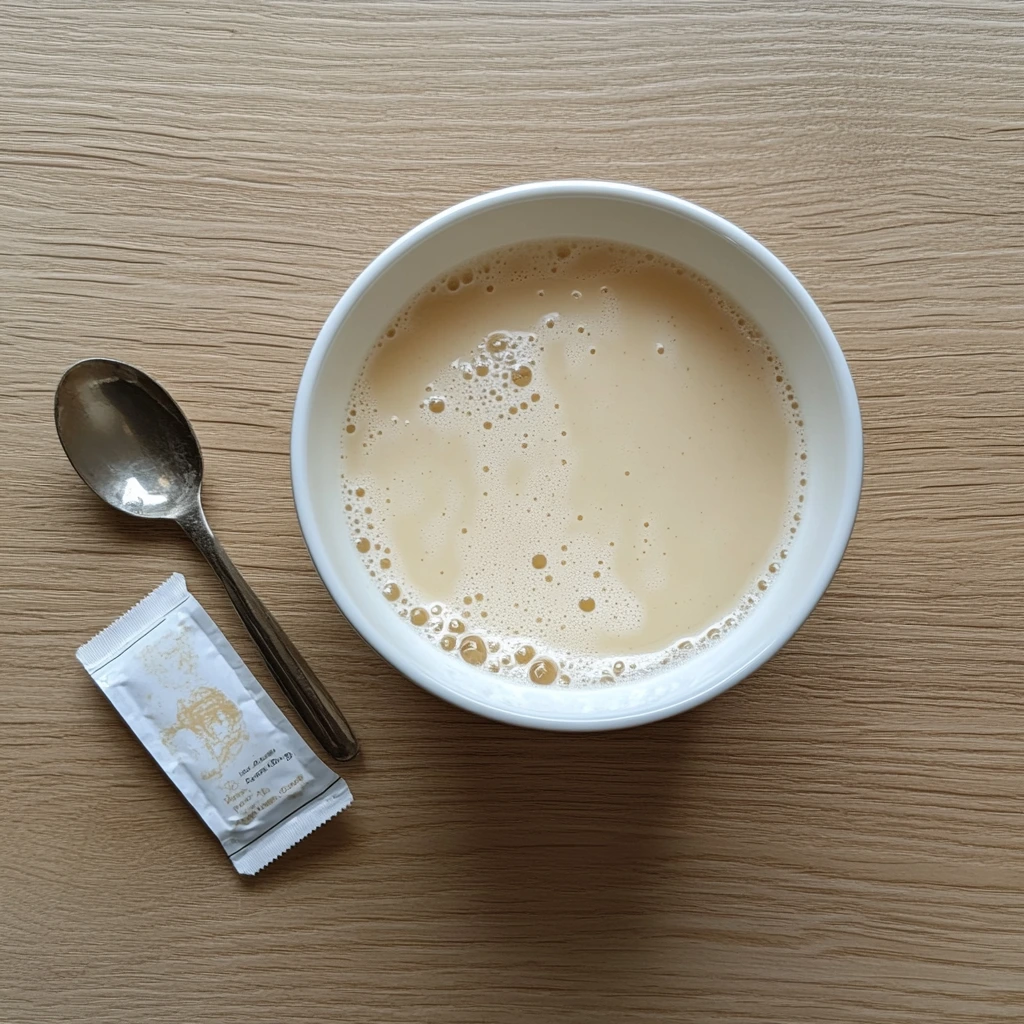
STEP 3: Let the Dough Rise
Once your dough is ready, transfer it to a lightly greased bowl. Give it a gentle turn to coat all sides in oil (this helps prevent sticking), then cover it with a clean kitchen towel or plastic wrap. Set it in a warm, draft-free spot and let it rise for 1 to 1.5 hours, or until it has doubled in size.
Tip: If your kitchen is a little chilly, try placing the bowl in your oven with just the light on (no heat). It creates the perfect cozy environment for rising dough.
STEP 4: Shape the Bomboloni
After the first rise, punch down the dough to release any air bubbles, then turn it out onto a floured surface. Divide the dough into 12 to 16 equal portions depending on how big you want your Bomboloni. Roll each portion into a smooth ball—don’t worry if they’re not perfect. They’ll puff up beautifully in the next step.
Place your dough balls on a parchment-lined baking sheet, making sure to leave some space between them. Cover loosely with a towel and let them rise again for 30 to 45 minutes. They should be soft and slightly puffy when they’re ready for frying.
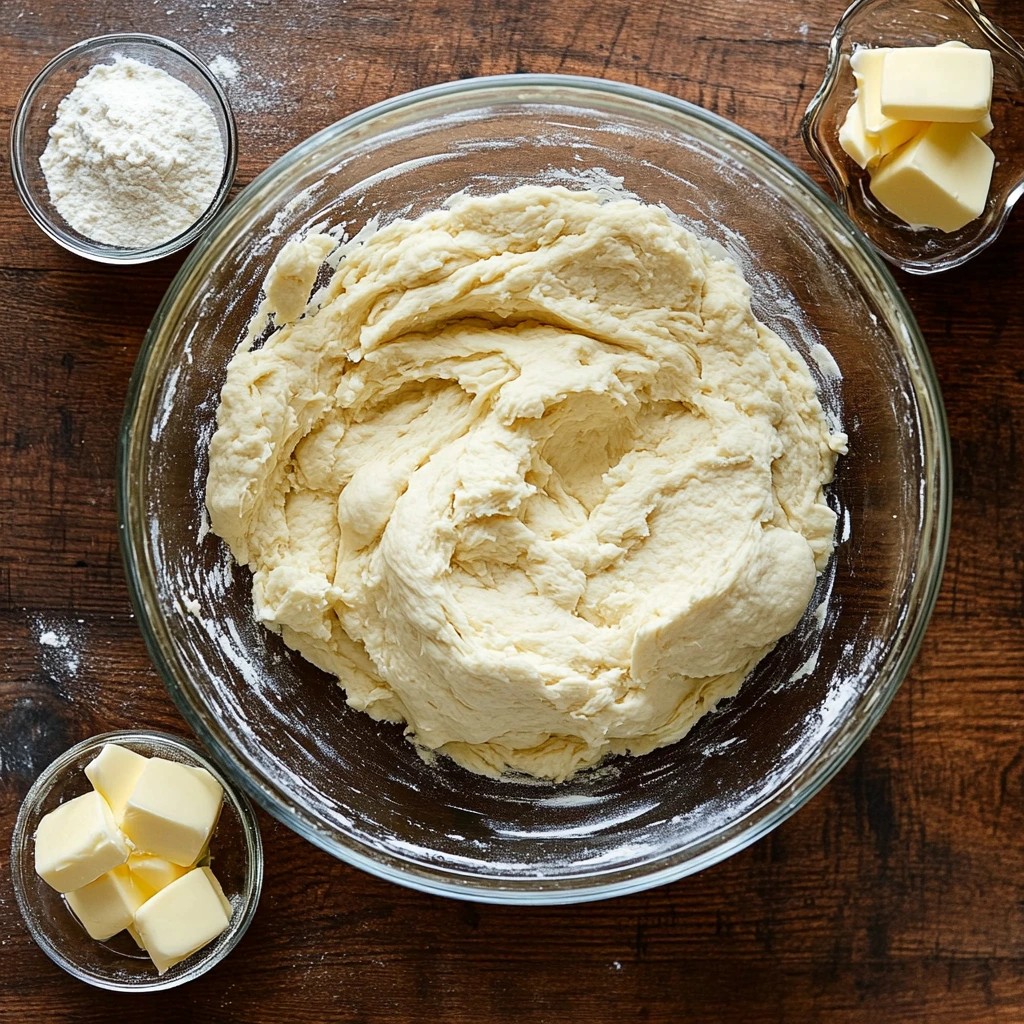
How to Fry, Fill, and Perfect Your Bomboloni Donuts
Alright, now that our dough has risen twice and the Bomboloni are looking puffed and ready, it’s time for the best part—frying and filling! This step can feel a little intimidating if you’re not used to deep frying at home, but I promise it’s much easier than it seems. With the right temperature and a few simple tricks, you’ll be turning out golden, bakery-style donuts in no time.
Let’s dive into the next steps and get these beauties cooked, coated in sugar, and filled with all kinds of sweet deliciousness.
STEP 5: Fry to Golden Perfection
In a heavy-bottomed pot or deep skillet, heat your vegetable oil to 350°F (175°C). I highly recommend using a thermometer here to keep things consistent—too hot and your Bomboloni will brown too fast on the outside while staying raw inside; too cool and they’ll soak up too much oil and turn greasy.
Once your oil is hot and steady, carefully lower a few dough balls into the pot. Don’t overcrowd—give them space to puff and float. Fry for 2 to 3 minutes per side, flipping once with a slotted spoon or tongs, until they’re golden brown all over.
As each batch finishes, transfer the donuts to a paper towel-lined plate to drain for a minute or so. While they’re still warm (but not piping hot), roll them generously in granulated sugar so they’re coated all over.
The sugar sticks best when the Bomboloni are warm, so don’t wait too long. At this point, they’re already looking amazing—but we’re not done yet!
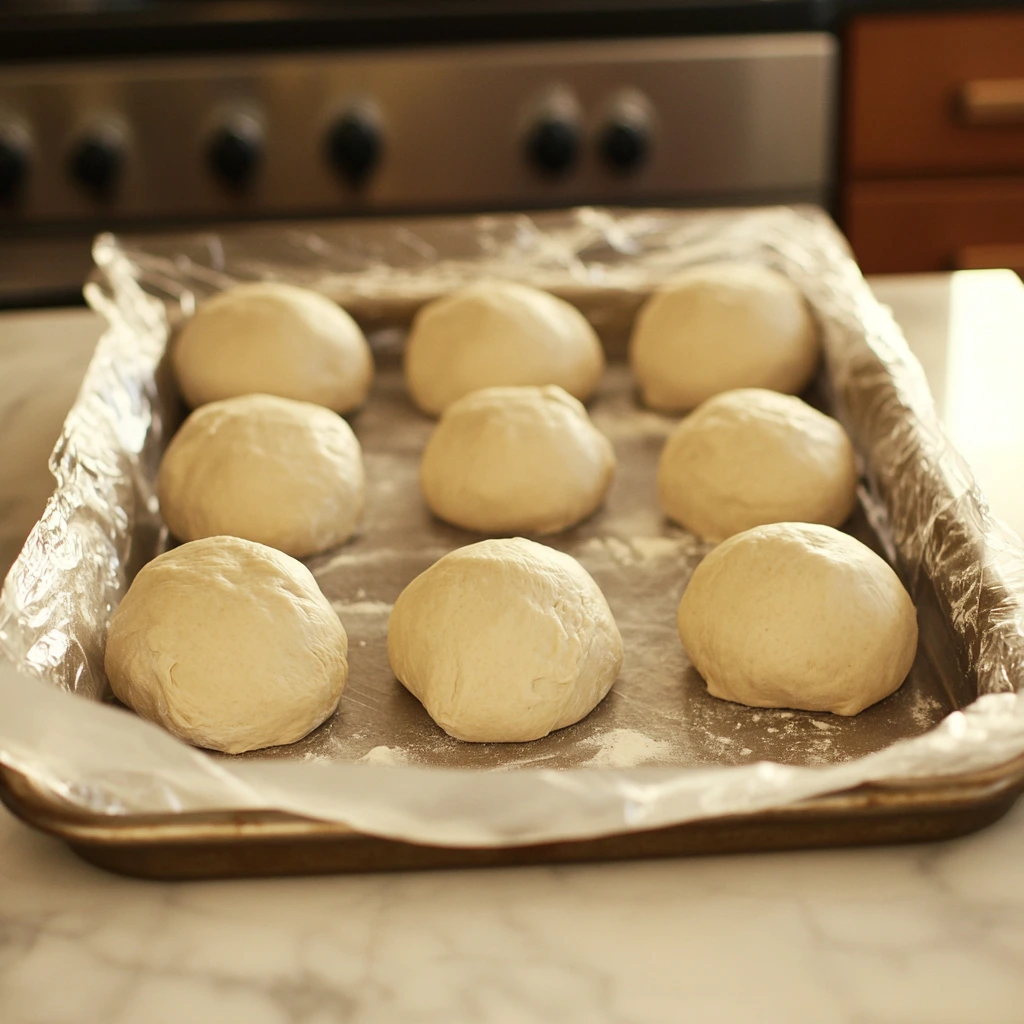
STEP 6: Fill with Your Favorite Cream or Spread
This is where Bomboloni become something truly special.
Let your sugared donuts cool slightly, just enough so they won’t melt your filling. Then, using a piping bag fitted with a long, narrow tip, insert the tip about halfway into each donut and gently squeeze to fill. You’ll feel the Bomboloni swell slightly as the filling goes in—don’t overdo it, but don’t be stingy either!
Here are a few of my favorite fillings:
-
Pastry Cream – The classic choice. Silky, rich, and perfectly sweet.
-
Nutella – Hazelnut and chocolate make these taste like a dream.
-
Raspberry Jam – Adds a fruity tartness that balances the richness.
-
Dulce de Leche – For a caramel-lovers’ version that melts in your mouth.
You can even mix and match if you’re making a batch for a group. Just be sure to label them or cut one open to surprise your guests!
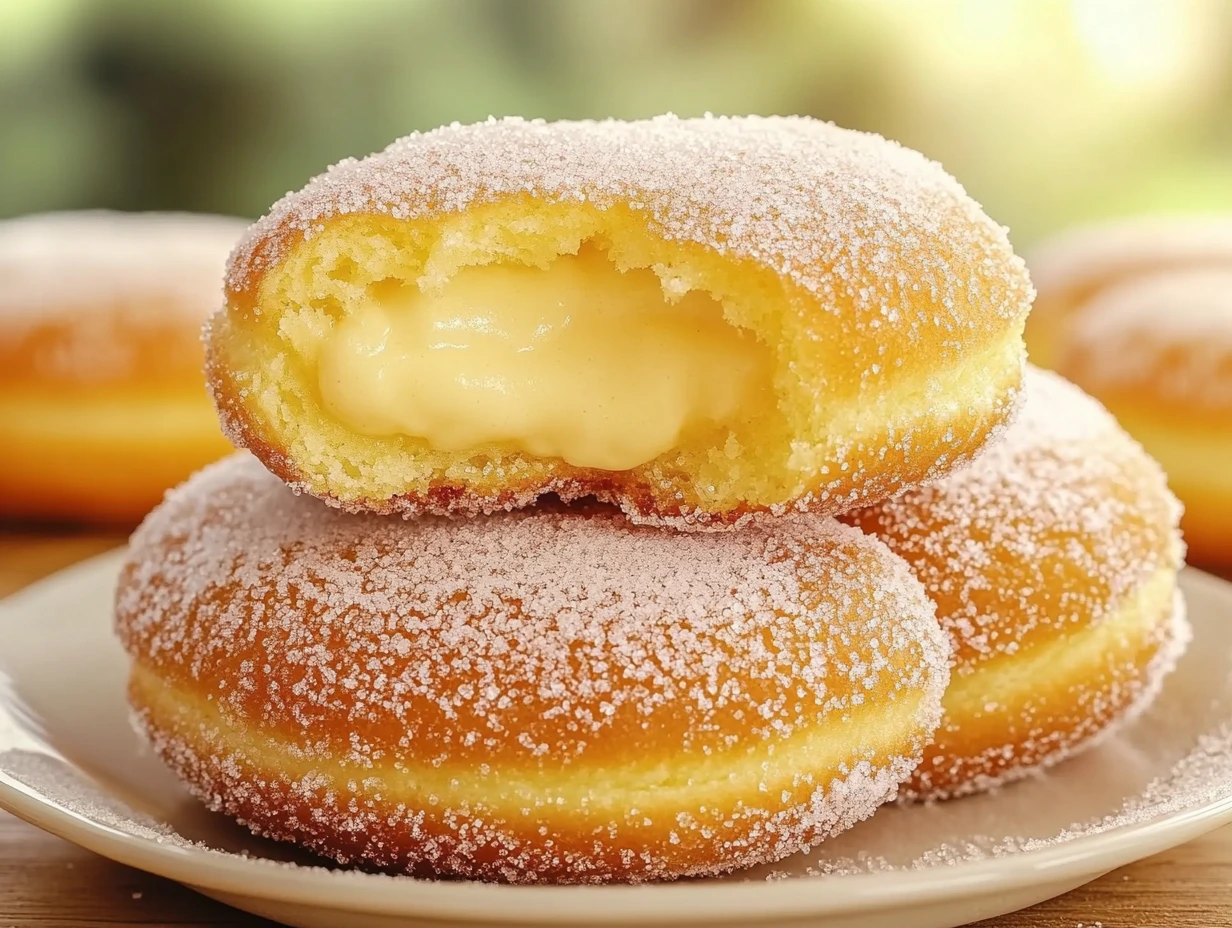
Tips for the Perfect Bomboloni
I’ve made my fair share of mistakes learning how to make these, so here are some tried-and-true tips to make sure yours turn out just right:
-
Use room temperature ingredients. Especially the eggs and butter—cold ingredients can prevent the dough from rising properly.
-
Don’t skip the second rise. That extra 30-45 minutes makes all the difference in achieving that soft, airy interior.
-
Keep your oil temperature steady. If it drops too low, your Bomboloni will absorb oil and taste heavy. Use a thermometer and fry in small batches.
-
Use a light hand with the flour. Adding too much can make the dough dense and dry. Only use as much as needed for the dough to be slightly tacky, not sticky.
-
Make ahead: You can prepare the dough the night before and let it rise in the refrigerator. Just take it out and let it come to room temperature before shaping.
Variations to Try
Once you’ve nailed the classic version, there’s plenty of room to get creative. Here are a few fun twists you might love:
-
Cinnamon Sugar Coating: Swap the plain sugar for a mix of cinnamon and sugar for a warm, spicy twist.
-
Lemon Zest in the Dough: Add a teaspoon of lemon zest to the dough for a bright citrus flavor that pairs beautifully with fruit fillings.
-
Drizzle with Melted Chocolate: After filling, give your Bomboloni a light drizzle of dark or white chocolate for an extra indulgent touch.
Bomboloni FAQ + Final Thoughts
By now, your kitchen is probably smelling like a dream, and those sugar-coated Bomboloni are calling your name. But before you dive in, let’s go over a few of the most common questions that tend to come up when making these Italian donuts from scratch.
Whether you’re making these for the first time or you’ve tried a few versions already, the tips below can help you get the most out of this recipe—and avoid a few rookie mistakes along the way.
Frequently Asked Questions
1. Can I bake Bomboloni instead of frying them?
Technically, yes—but they won’t have the same texture or flavor. Bomboloni are meant to be fried, and that’s what gives them their signature lightness and slightly crisp exterior. Baking them will create more of a soft bread roll than a donut.
2. Can I freeze the dough or the finished donuts?
Yes! You can freeze the dough balls before the second rise—just let them thaw and rise fully before frying. Fully cooked and unfilled Bomboloni can also be frozen for up to one month. Reheat in the oven, then fill and coat in sugar just before serving.
3. What kind of oil is best for frying?
Neutral oils with a high smoke point work best. I like using vegetable oil, but canola or peanut oil also work well. Avoid oils with strong flavors, like olive oil, as they can overpower the donut.
4. How do I know when the donuts are done frying?
Each Bombolone should be golden brown on both sides after about 2 to 3 minutes per side. You can also test one by cutting it open to ensure it’s cooked through—no doughy center.
5. What’s the best way to pipe the filling without making a mess?
Use a piping bag fitted with a narrow tip (like a Bismarck tip). Insert it halfway into the donut and apply steady pressure while slowly pulling the tip back out. Don’t overfill, or the Bomboloni might split or leak.
6. Can I make them smaller for mini Bomboloni?
Absolutely. Just divide the dough into smaller portions—around 20 to 24—and reduce frying time to about 1 to 1½ minutes per side. They’re perfect for parties or brunch buffets.
7. Why is my dough sticky or too dense?
If your dough is too sticky, add flour a tablespoon at a time until it’s tacky but manageable. If it’s dense after frying, you may have added too much flour or not let it rise long enough. Soft, enriched dough takes time—be patient and let it rise until doubled.
Final Thoughts: Why These Bomboloni Are Worth the Effort
There’s something deeply satisfying about making a batch of homemade Bomboloni. From the gentle kneading to the moment you bite into that soft, cream-filled center—it’s a full sensory experience that’s hard to beat. And while they might look fancy, these donuts are totally manageable with a bit of time and love.
If you’re like me, you’ll find yourself reaching for this recipe any time you want to make something special. I’ve served these at birthday brunches, brought them to work (they disappeared in minutes), and even made them just because my kids asked for “those sugar donuts with stuff inside.”
Remember, don’t stress about perfection here. A slightly wonky shape or a bit of sugar everywhere just adds to the homemade charm. What matters most is that soft, rich dough and the joy of sharing something sweet and made with care.
If you give these a try, I’d love to hear how they turn out! Drop a comment below, share your favorite filling, or let me know if you added your own twist. Whether you stick with the classics or experiment with flavors, these Bomboloni are sure to become a go-to favorite in your kitchen.
Happy frying—and enjoy every sugary bite!
PrintBomboloni (Italian Donuts)
Bomboloni are pillowy Italian donuts that are fried to golden perfection, then filled with sweet creams or jams and rolled in sugar. With their tender interior and rich, buttery flavor, these treats are a favorite in Italian bakeries and a delightful indulgence for special mornings or festive occasions.
- Author: Mark's Recipe
Ingredients
For the Dough:
2¼ teaspoons active dry yeast (1 packet)
½ cup warm milk (about 110°F / 43°C)
3½ to 4 cups all-purpose flour, divided
¼ cup granulated sugar
½ teaspoon salt
3 large eggs, at room temperature
½ cup unsalted butter, softened
1 teaspoon vanilla extract
Vegetable oil, for frying
For the Filling:
Pastry cream, Nutella, jam, or dulce de leche
For the Coating:
1 cup granulated sugar, for rolling
Instructions
1️⃣ In a small bowl, stir the warm milk and yeast together. Let sit for 5 to 10 minutes, or until the mixture is frothy and activated.
2️⃣ In a large bowl or the bowl of a stand mixer, whisk together 3 cups of flour, sugar, and salt. Add the yeast mixture, eggs, softened butter, and vanilla. Mix until a shaggy dough forms. Knead for 8 to 10 minutes, adding the remaining flour as needed until the dough is smooth, elastic, and slightly tacky but not sticky.
3️⃣ Transfer the dough to a lightly greased bowl, turning to coat. Cover with a kitchen towel or plastic wrap and let it rise in a warm, draft-free area for 1 to 1.5 hours, or until doubled in size.
4️⃣ Punch down the risen dough and turn it out onto a floured surface. Divide into 12 to 16 equal portions and roll each into a smooth ball. Place the balls on a parchment-lined baking sheet with space between each. Cover loosely and let rise again for 30 to 45 minutes, or until puffy.
5️⃣ Heat vegetable oil in a deep skillet or heavy pot to 350°F (175°C). Fry the Bomboloni in batches, turning occasionally, for about 2 to 3 minutes per side or until golden brown. Use a slotted spoon to transfer them to a paper towel-lined plate to drain briefly. While still warm, roll the Bomboloni in granulated sugar until well coated.
6️⃣ Allow them to cool slightly. Using a piping bag with a long, narrow tip, fill each Bomboloni with your choice of pastry cream, Nutella, jam, or dulce de leche. Insert the tip halfway into the donut and gently squeeze the filling inside.
Notes
Bomboloni are best enjoyed fresh the same day. You can prepare the dough a day ahead and let it rise overnight in the fridge. For a more decadent variation, dust the filled Bomboloni with powdered sugar or drizzle them with melted chocolate.


